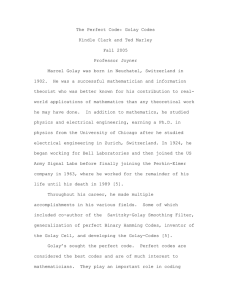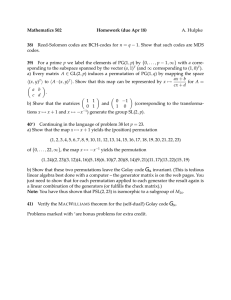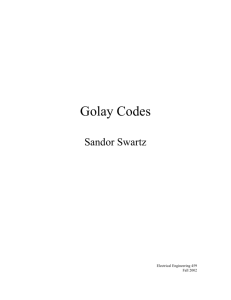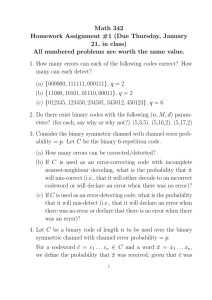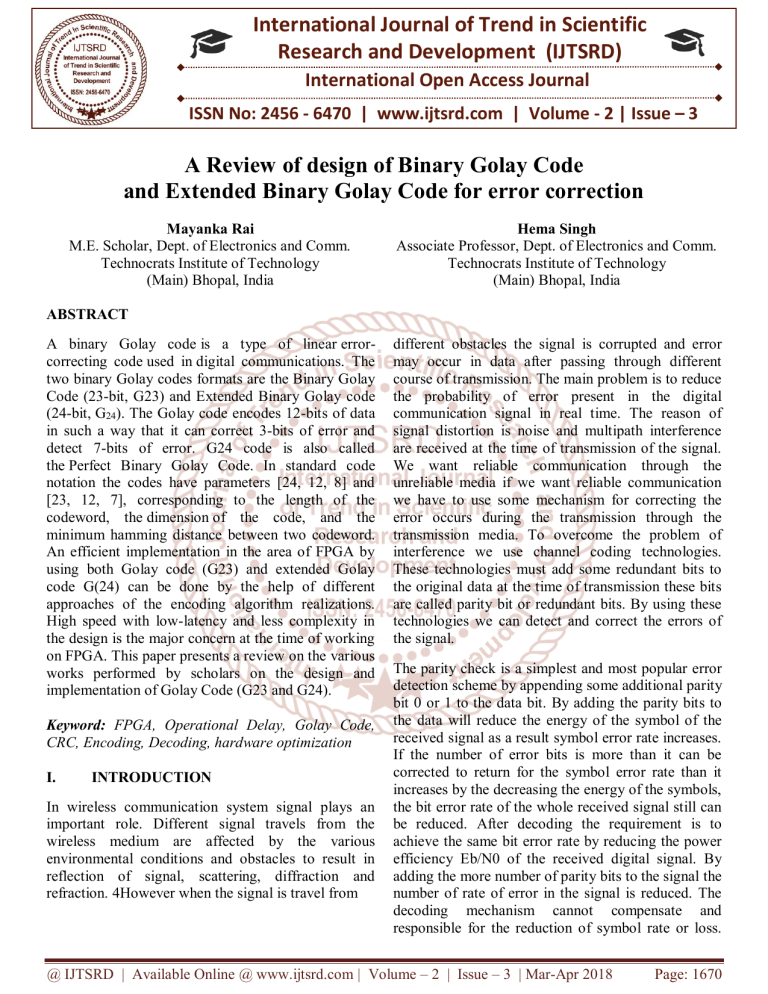
International Journal of Trend in Scientific
Research and Development (IJTSRD)
International Open Access Journal
ISSN No: 2456 - 6470 | www.ijtsrd.com | Volume - 2 | Issue – 3
A Review of design of Binary Golay Code
and Extended Binary Golay Code for error correction
Mayanka Rai
M.E. Scholar, Dept. of Electronics and Comm.
Technocrats Institute of Technology
(Main) Bhopal, India
Hema Singh
Associate Professor, Dept. of Electronics and Comm.
Technocrats Institute of Technology
(Main) Bhopal, India
ABSTRACT
A binary Golay code is a type of linear errorcorrecting code used in digital communications. The
two binary Golay codes formats are the Binary Golay
Code (23-bit, G23) and Extended Binary Golay code
(24-bit, G24). The Golay code encodes 12-bits of data
in such a way that it can correct 3-bits of error and
detect 7-bits of error. G24 code is also called
the Perfect Binary Golay Code. In standard code
notation the codes have parameters [24, 12, 8] and
[23, 12, 7], corresponding to the length of the
codeword, the dimension of the code, and the
minimum hamming distance between two codeword.
An efficient implementation in the area of FPGA by
using both Golay code (G23) and extended Golay
code G(24) can be done by the help of different
approaches of the encoding algorithm realizations.
High speed with low-latency and less complexity in
the design is the major concern at the time of working
on FPGA. This paper presents a review on the various
works performed by scholars on the design and
implementation of Golay Code (G23 and G24).
Keyword: FPGA, Operational Delay, Golay Code,
CRC, Encoding, Decoding, hardware optimization
I.
INTRODUCTION
In wireless communication system signal plays an
important role. Different signal travels from the
wireless medium are affected by the various
environmental conditions and obstacles to result in
reflection of signal, scattering, diffraction and
refraction. 4However when the signal is travel from
different obstacles the signal is corrupted and error
may occur in data after passing through different
course of transmission. The main problem is to reduce
the probability of error present in the digital
communication signal in real time. The reason of
signal distortion is noise and multipath interference
are received at the time of transmission of the signal.
We want reliable communication through the
unreliable media if we want reliable communication
we have to use some mechanism for correcting the
error occurs during the transmission through the
transmission media. To overcome the problem of
interference we use channel coding technologies.
These technologies must add some redundant bits to
the original data at the time of transmission these bits
are called parity bit or redundant bits. By using these
technologies we can detect and correct the errors of
the signal.
The parity check is a simplest and most popular error
detection scheme by appending some additional parity
bit 0 or 1 to the data bit. By adding the parity bits to
the data will reduce the energy of the symbol of the
received signal as a result symbol error rate increases.
If the number of error bits is more than it can be
corrected to return for the symbol error rate than it
increases by the decreasing the energy of the symbols,
the bit error rate of the whole received signal still can
be reduced. After decoding the requirement is to
achieve the same bit error rate by reducing the power
efficiency Eb/N0 of the received digital signal. By
adding the more number of parity bits to the signal the
number of rate of error in the signal is reduced. The
decoding mechanism cannot compensate and
responsible for the reduction of symbol rate or loss.
@ IJTSRD | Available Online @ www.ijtsrd.com | Volume – 2 | Issue – 3 | Mar-Apr 2018
Page: 1670
International Journal of Trend in Scientific Research and Development (IJTSRD) ISSN: 2456-6470
So the selection of coding is important. The decoding
capability of the channel code is influence by the
coding rate that determined by the number of
information bits and parity-bits.
In wireless communication channel coding improve
the bit error rate of signal in transmission. The most
frequent problem in wireless communication is noise
and interference from different obstacles. To solve
this problem block interleaving is one of the most
appropriate methods to break up the burst error in to
discontinuous random error to bring the capability of
channel coding to correct errors. More complexity
encountered at the time of encoding and encoding
become complicated, software becomes complex and
the design of hardware is very complicated.
There are three steps used to transfer the information
in which the transmitter transmit, receiver receives
and transmission media is used to transfer the
information. In an alternative that at the time of
transmitting the information the data is changed to
noise so to avoid this condition we use error
correcting codes. As shown in Fig. 1, the message is
encoded into a codeword, it is sent to the receiver
through a channel, there is a possibility to exist the
error occurs in the channel, so the receiver tries to
obtain the original message by decoding the word.
Fourth property says that the hamming distance of
a two vectors belongs to a function Fn is the
number of place where they differ. The method is
that an n-code C is a strict subset of Fn in which
we want the Hamming distance between any two
vectors to be as large as possible.
Fifth property says that the minimum Hamming
distance d of a code C is defined as d = min
{dist(x, y) I x, y belongs to C} where c is the
code.
Sixth property says that an (An (n, M, d)-code C is a
set of M vectors in Fn2, such that dist(x, y) >d for all
x, y all C. Its block length is n and M is its dimension.
II.
Golay Code Algorithm
A binary Golay code is represented by (23, 12, 7)
shows length of the codeword is 23-bits while
message is of 12-bits and the minimum distance
between two binary Golay code is 7. This paper
shows AE3h as characteristic polynomial which is of
12 bit binary number can be encoded into a 23-bit
Golay code by using the long division method to
generate check bits (11-bit) information and 12 bit
data together make the Golay code of 12-bit data. For
extending a Golay code (24, 12, 8) generated by
adding a parity bit with the binary Golay code. B
matrix is shown in Fig. 2.
Fig. 1- Process of Error correction codes
Transmission of message depends on what we have
sent and what is received. Extended Golay code
describe some important properties for such codes as First property says that the message m of length k
is a sequence of k symbol out of finite field F, so
m= (m1::mk) belongs to Fk .Then an n-code C
over a finite field F is a set of vectors in Fn, where
n ≤ k. Since we will be dealing with a binary code
only, now we assume codes are in binary form.
Second property says probability of error p is the
probability that 1 is received when 0 was sent, or
0 is received when 1 was sent.
Third property says that the hamming weight of a
vector belongs to a function Fn is the number of its
non zero elements.
Fig. 2- Matrix-B
The steps of algorithm required to achieve the
encoding procedure as follows1) A charateristic polyniminal is preferred for check
bits generation.
2) ‘M’ bit of data contribute in long division method
with the charateristic polynominal. So 11 zero are
apppended to the right of the m bit of data.
3) Check bits for G(23) are obtained by MSB
resulted at the end of the long division method.
4) By appending the check bits with the message the
encoded Golay code (23, 12, 7) codeword are
obtained.
@ IJTSRD | Available Online @ www.ijtsrd.com | Volume – 2 | Issue – 3 | Mar-Apr 2018
Page: 1671
International Journal of Trend in Scientific Research and Development (IJTSRD) ISSN: 2456-6470
5) A parity bit is added for the conversion of binary
Golay code into the extended binary Golay code
(24, 12, 8). If the weight of binary Golay code is
odd then then parity bit 1 is appended, otherwise 0
is appended.
As shown in the Fig. 3, the characteristic polynomial
101011100011 and 12-bit data is 101000100111. The
11- bits check bits sequence is generated by long
division method is 10000110101. The 23-bit encoded
Golay codeword (G23)
is
10100010011110000110101. A parity bit is added for the conversion
of binary Golay code into the extended binary Golay
code. In the G(23) word the weight is 11, i.e., the
encoded word has 11 1‟s, so a 1 will be appended in
it. This will generate extended codeword G(24) as
(101000100111-10000110101-1). Generation of
parity bits is implemented by XOR operation of the
bits of G(23) codeword. In verified G(24) codeword
the weight is multiple of 4 and greater than equal to 8.
The weight of the G(24) codeword is 12, so it is a
valid codeword.
Fig. 3: Long–Division of data for check bit
Generation [1]
The steps of algorithm are required to achieve the
decoding process are enlisted as follows:
1) For the received codeword ‘W’ and matrix
‘H’, where H = [I / B] Compute the Syndrome
‘S’.
2) Error vector, E = [S, 0], If weight of ‘S’ is less
than or equal to 3, i.e., wt(S) ≤ 3.
3) If wt(S+Bi) ≤ 2, then E = [S+Bi, Ii]. Where Ii
represents ith row of the identity matrix I.
4) The second syndrome SB can be computed.
5) If wt(SB) ≤ 3, then E = [0, SB].
6) If wt(SB+Bi) ≤ 2, then E = [Ii, S+Bi].7) If E
is still not determined then received data is
required to be retransmitted.
In this paper the first section gives the introduction
about the problem of occurrence at the time of
transmission of signal and how to resolve it. Second
section gives a brief about the Golay Code encoder
and decoder algorithm. The third section is literature
review that presents the work of scholars. Fourth
section is conclusion and the last section is about the
reference paper
III.
LITERATURE REVIEW
An efficient hardware implementation of the encoding
the algorithm in field programmable gate array
(FPGA) prototype for both the binary Golay code
(g23) and extended binary golay code (g24). The high
speed architecture with low latency has been designed
and implemented in virtex-4 explained in reference
[1]. These hardware modules for encoder and decoder
can be a good candidate for various applications in
high speed communication links, photo spectroscopy,
and ultrasonography.
In reference [2] a lossless binary coding scheme used
for the reception of the correct data information and to
overcome the problem of power loss which is
introduced by ternary coding scheme, 23 binary
symbols which yields the power saving one and a half
dB for omitting probability of the errors and this code
is called Golay code. And another code is also
introduced by him called extended Golay code but it
is not that much power efficient it yields the power
saving up to 3dB. A brief introduction of Golay code
scheme explained in reference [3]. It also explains the
properties of Golay code. A GF (2m) Galois field
encoder & decoder its verification on FPGA Spartan
xc3s50-5pq208using the NIST chosen irreducible
polynomial.
[4] Proposed the design and implementation of 4-bit
Galois Encoder and Decoder based on FPGA. The
paper presents the simple circuit and performs high
speed operation by increases the security during
communication and decreasing the number of logic
gates. This [5] paper proposed the extended Golay
code a simplified soft decoding algorithm up to four
bit errors for the (24, 12, 8). The simulation results
show that the coding gains obtained by the simplified
decoding algorithm in terms of power gain, cost and
hardware complexity. The binary Golay code (24, 12,
8) can be constructed as the direct sum of two array
@ IJTSRD | Available Online @ www.ijtsrd.com | Volume – 2 | Issue – 3 | Mar-Apr 2018
Page: 1672
International Journal of Trend in Scientific Research and Development (IJTSRD) ISSN: 2456-6470
codes involving [6] four component codes, two of
which are simple linear block codes and other two are
symmetric code and its extended version.
In [7] Golay complementary sequences were
introduced by Marcel Golay, the context of infrared
spectrometry along with the properties and their
application in different fields. The work in [8] present
a new algorithms decoding the (23, 12, 7) and the (41,
21, 9) Quadratic Residue (QR) codes by using LUT
which directly determine the location of the error
without multiplication operation over finite field. An
efficient coset based symbol-by-symbol soft-in/softout APP decoding algorithm is presented in [9] for the
Golay code. It also examined the iterative decoding of
concatenated Golay codes.
[10] observe the efficiency of turbo code (BPTC) and
simulated its efficiency, used the Hamming (15,11)
and Hamming (13,9) block channel code
combinations and block interleaving to construct a
BPSK modulation and BPTC coding system in the
concept of feedback encoding in turbo code. This
study also analyzed and simulated special
combination of MSK modulation with Golay. A new
technique in [11] of fault-tolerant hashing based on
reversing the conventional usage of error correction
codes (24, 12, 8) to map 24-bit vector into 12-bits
message words. To overcome the 24-bit restriction
size of the binary attribute vectors would result in a
less regular structure of the reference indices.
A method in [12] proposed of constructing a sequence
of phase-coded waveforms, for which the uncertainty
of the function is free of range side lobes along
modest Doppler shifts. The problem with this that the
ideal ambiguity along zero Doppler-axis but it is
sensitive to non-zero Doppler shifts. The application
of pulse coded waveform is in the area or
communication using radar. The [13] present an
efficient medical Big Data processing model which is
based on Golay Code clustering algorithm. It diverse
information items in a data stream mode. This
approach is used in the field where the requirement to
accumulate multidimensional data.
A new technique in [14] on low complexity trellis
decoding of linear block codes. The designed trellises
have a regular structure and allow low-complexity
VLSI and DSP implementations. [15] Present a
technical report on Golay and Wavelet error control
codes in VLSI. Two coders have been implemented: a
(12, 6, 4) wavelet encoder/decoder and a (24, 12, 8)
Golay encoder and decoder. It is expected that the
chip would function as a high-speed error encoder and
decoder for Radio Frequency applications.
In reference [16] paper proposed an efficient softdecision decoder of the (23, 12, 7) binary Golay code
up to the four errors. The method developed in this
paper can be generalized to decode for more than four
errors occurred. The paper presents the inequivalent
binary Golay code sequence pair of length from odd
length, involving a Barker sequence explained in [17].
The paper [18] presents the error detection and
correction using the hamming code and Golay code.
Hamming code is the linear error correcting code help
to detect and correct the single bit errors occurred at
the time of transmission of data.
IV.
CONCLUSION
This paper presents a review work in the field of
FPGA based optimization of hardware architecture
and bust error reduction etc. In this paper different
types of encoding and decoding methods were
reviewed for speed optimization. The aim of these
papers is is to fulfill the requirement of high speed
application low hardware complexity of the system.
So in future new scheme may be proposed for FPGA
using both binary Golay code (G23) and extended
binary Golay (G24).
REFERENCES
1. Satyabrata Sarangi and Swapna Banerjee,
“Efficient Hardware Implementation of Encoder
and Decoder for Golay Code”, IEEE Transaction
on very large scale Integration (VLSI) system,
Vol.23 Issue No.9, pg.1965-1968, September
2015.
2. Marcel J.E.GOLAY “Notes on Digital Coding”,
Reprinted from proc. IRE, Vol.37, pg-657 June
1949.
3. Mario de Boer and Ruud Pellikaan, “The Golay
codes” Springer, pg.338-347, September 1995.
4. Dr. Ravi Shankar Mishra, Prof Puran Gour and
Mohd Abdullah, “Design and Implementation of 4
bits galois Encoder and Decoder in FPGA”,
International Journal of Engineering Science and
Technology (IJEST), Vol.3 No.7, pg.5724-5732,
July 2011.
@ IJTSRD | Available Online @ www.ijtsrd.com | Volume – 2 | Issue – 3 | Mar-Apr 2018
Page: 1673
International Journal of Trend in Scientific Research and Development (IJTSRD) ISSN: 2456-6470
5. Dongfu Xie, “Simplified algorithm and hardware
implementation for the (24,12,8) Extended golay
soft Decoder up to 4 Errors”, The International
Arab Journal of Information Technology, Vol.11
No.2, pg.111-115, March 2014.
6. Xiao-Hong Peng and Paddy G. Farrell” On
Construction of the (24, 12, 8) Golay Codes”,
December 2005.
7. Matthew G. Parker, Kenneth G. Paterson and
Chintha Tellambura, “Golay Complementary
Sequences”, January 2004.
8. Yan-Haw Chen, Chih-Hua Chine, Chine-Hsiang
Huang, Trieu- Kien Truong And Ming-Haw Jing,
“Efficient Decoding of schematic (24,12,7) and
(41,21,9) Quadric Residue codes”,Journal of
Information science And Engineering Vol.26,
pg.1831-1843, December 2010.
9. Li Ping and Kwan L. Yeung, “Symbol-bySymbol APP Decoding of the Golay Code and
Iterative Decoding of Concatenated Golay
Codes”, IEEE Transaction on Informationtheory,
Vol.45, No.7, pg.2558-2562, November 1999.
14. B. Honary, G. Markarian, and M. Darnel, “Lowcomplexity trellis decoding of linear block codes”,
IEE Proc.-Commun., Vol. 142, No. 4, pg. 201209, August 1995.
15. Arunkumar Balasundaram, Angelo Pereira, Jun
Cheol Park and Vincent Mooney, “Wavelet Error
Control Codes in VLSI” IEEE Press Piscataway,
pg. 563-564, January 2004.
16. Wen-Ku Su, Pei-Yu Shih, Tsung-Ching Lin, and
Trieu-Kien Truong, “Soft-decoding of the (23, 12,
7)
Binary
Golay
Code”,
International
MultiConference of Engineers and Computer
Scientists IMECS, Vol II, pg.1191, March2008.
17. Jonathan Jedwab and Matthew G. Parker,
“construction of binary Golay sequence pairs from
odd-length Barker sequences”, Journal of
Combinatorial Designs, Vol. 17, pg. 478-491,
September 2008.
18. Satish kumar Buddha, “Hamming and Golay
Codes”, December 2011.
10. Yihua Chen, Juehsuan Hsiao, PangFu Liu and
Kunfeng Lin, “Simulation and Implementation of
BPSK BPTC of MSK golay code in DSP chip”,
Communications in Information Science and
Management Engineering, Vol.1 No.4, pp.46-54,
Nov.2011
11. Eyas El-Qawasmeh, Maytham Safar and Talal
Kanan, “Investigation of golay code (24,12,8)
Structure in improving search techniques”, The
International Arab Journal of Information
Technology, Vol.8, No.3, pg.265-271, July 2011.
12. Ali Pezeshki, A. Robert Calderbank, William
Moran andStephen D. Howard, “Doppler Resilient
Golay Complementary Waveforms”, IEEE
Transaction on Information Theory Vol.54, No.9 ,
pg.4254-4266, September 2008
13. Faisal Alsaby, Kholood Alnoowaiser and simon
Berkovich, “Golay code Transformation for
ensemble clustering in application of medical
Diagnostics”, International Journal of Advanced
Computer Science and Applications (IJACSA),
Vol.6 No.1, pg.49-53, 2015. Calderbank, William
Moran andStephen D. Howard, “Doppler Resilient
Golay Complementary Waveforms”, IEEE
Transaction on Information Theory Vol.54, No.9 ,
pg.4254-4266, September 2008.
@ IJTSRD | Available Online @ www.ijtsrd.com | Volume – 2 | Issue – 3 | Mar-Apr 2018
Page: 1674

